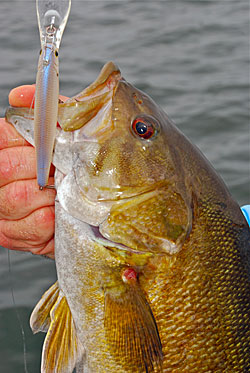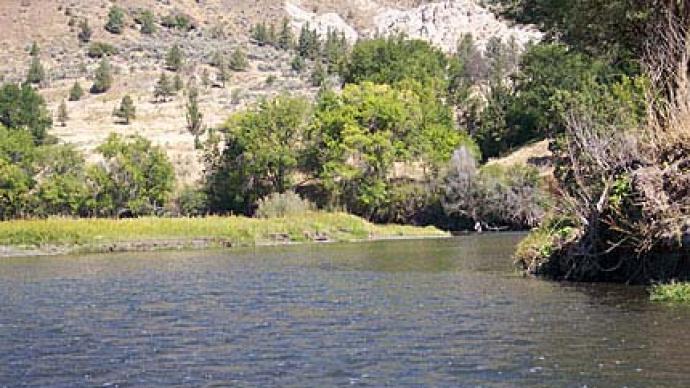
Some of the best bassin’ in the country is taking place on Great Lake bays, estuaries, and connecting waters. Smallmouth numbers have exploded and are producing incredible fishing in locations like Sturgeon Bay, Lake St. Clair, the Thousand Islands, and many other places.
While these locales are loaded with hefty bass, they are also large bodies of water, and concentrations of bass can be hard to find in these wide-open spaces. The best way to eliminate water and find concentrations of smallmouth is by burning crankbaits. You can cast crankbaits a mile and speed-reel them back to the boat while covering lots of water. It’s a great way to search and destroy.
“There’s little doubt that burning crankbaits is the best way to locate open-water smallmouths,” claimed bass pro Joe Balog. “Right from the pre-spawn through late summer, cranking crankbaits is a great way of eliminating water and contacting big smallmouths.”
Bass spawn much later in these large, relatively cold bodies of water. The spawn may take place from late May into July. But without fail, once the spawn is complete, the bass will retreat to the first weeds they can find to look for food.
“Smallmouths typically collect around isolated patches of vegetation,” Balog said. “Almost universally in the north, these are sparse cabbage stands. They’re not huge weed beds, and you won’t find huge concentrations of bass on them, but each clump will hold a few good fish. Initially, smallies will spawn and gorge in the shallows, but they quickly move out and relate to cabbage edges in 7 to 13 feet of water. At that point, they’re very susceptible to jerkbaits and crankbaits like the Rapala DT5.”
The key is to locate known spawning areas and then work the first grass you come to outside the spawning areas. Smallmouths like to move over gradual sloping flats on their way to deeper water. Deep might be 8 feet in some places or 12 to 14 feet in others. The way to discover where the bass are recouping is by using a fast retrieve that occasionally contacts and deflects off the weeds. The weeds can be single strands of emerging cabbage or clumps.
“Target the middle of the water column,” Balog said. “Smallmouths are not like largemouths. The baits don’t have to come in contact with the bottom to trigger a strike, but deflecting off the grass is key. Once your crankbait contacts the weeds and hesitates, give it two or three sharp rips and hold on.”
It’s essential to target the middle of the water column. “With largemouths, you need a crankbait that dives 18 feet if you’re fishing in 16 feet of water,” offered Balog. “The bait must occasionally contact the bottom to trigger strikes from largemouths. That’s not the case with smallmouths. Smallies will come up for a bait.”
Balog admitted that he’d refined the speed-cranking technique over the years, and much of what he’s discovered goes against conventional wisdom. “Smallmouths attack a crankbait rather than engulfing it the way a largemouth would,” said Balog.
“Smallmouths may bump a lure a couple of times before smashing it. Or you might feel them bulge on it. Initially, they might not intend to eat it. Without a moderate-action 100% graphite rod, you won’t feel that. That explains why you often have smallmouths hooked on the outside of the mouth or caught just with the front hook. Largemouths will have the crankbait halfway down their throat. Pros use to promote glass rods with a parabolic bend for crankbait fishing, but if you use a rod like that for smallmouths, you won’t hook a fraction of the bass that hit.”
Balog uses a 7-foot, 7-inch medium-action Diawa Tatula casting rod. “The rod has some backbone but with a more sensitive tip,” Balog said. The rod is matched to a high-speed baitcasting reel filled with 10- to 12-pound fluorocarbon.

Balog also advised making some subtle changes to your lures to up the percentage of smallmouth bass that get hooked. “Change the hooks on your baits to one or two sizes bigger,” he advised. “Instead of a size six, go to a size five or four and use a standard strength, short-shanked treble. I use VMC hooks, but others are good, too. Because smallmouth crash a bait instead of inhaling it like a largemouth, you hook and catch more of those fish.”
Balog said he generally uses two baits when burning cranks for smallies. “I’m a big fan of the Rapala DT (Dives-To) series,” admitted Balog. “I use mainly natural colors. The DT series has a moderate wiggle with a rattle and casts like a bullet.” The DT series comes in models from 4 to 16, meaning they will drive from 4 to 16 feet. The most commonly used models for Balog’s smallmouth fishing are the 10, 14, and 16 models.
Another Balog favorite is the Strike King series 5, 5XD, and 6. “The Strike King Series 5 and 6 crankbaits are a little louder and gaudier. Just match the size to the depth you’re trying to achieve. There are times when silent baits work best, baits that don’t rattle. I’ve got some old C-Flash baits that I resort to then.”
Burning crankbaits is a technique that can work all year long. Once water temperatures reach 50 degrees or more, bass will invade the shallows to feed and stage for the pre-spawn. Shallow crankbaits and suspending stickbaits excel then as well as spinnerbaits and plastics.
Fast-cranking hard baits can help you cover more water. At some point in late spring, you’ll have bass coming and going. Not all the bass spawn at the same time, so there’s going to be a period when you’ll have pre-spawn, spawning and post-spawn bass leaving the shallows, especially when water temperatures are in the 58 to 66-degree range.
Once the spawn is over, look for bass to begin relating to the isolated weeds, stands in 8 to 12 feet of water, and when the water warms to a range of 64 to 69 degrees. You may not find significant concentrations of bass yet, but a good weed bed can hold three or four trophy bass. Choose crankbaits that are capable of running from 6 to 10 feet then.
Warming temperatures and consistent weather patterns put smallies on full attack mode. Look for schools of smallies relating to weeds in 12 to 16 feet of water once surface temperatures reach 70 degrees. There will be more and larger stands of weeds to relate to then, but expect to find most bass hunting near sparse, isolated stands of cabbage. Burning cranks that can reach 10 to 16 feet and making sure that they contact and deflect off weeds will have 5-pound smallmouths jumping all over them. The bite continues through late summer as long as the bass stay inside 20 feet.
“A key to finding small pods of bass is locating scattered weeds with my Humminbird Side Imaging graph,” explained Balog. “The graph will show me where the weeds are, but equally important is my Aqua-Vu camera. The camera will tell me if those weeds are lying over because there is a current in the area. Smallies will always lay on the down current side of the weeds, and you want to ensure that you’re retrieving the crankbait up the current as you drift.”
BassResource may receive a portion of revenues if you make a purchase using a link above.




